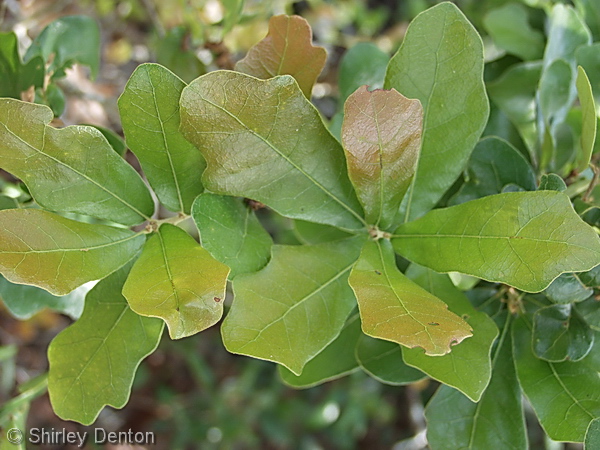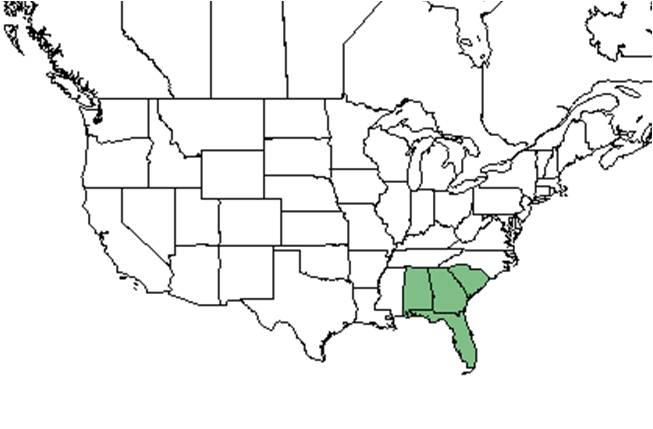Difference between revisions of "Quercus chapmanii"
(→Ecology) |
|||
| Line 46: | Line 46: | ||
<!--===Fire ecology===--> <!--Fire tolerance, fire dependence, adaptive fire responses--> | <!--===Fire ecology===--> <!--Fire tolerance, fire dependence, adaptive fire responses--> | ||
| − | ===Pollination=== | + | ===Pollination and use by animals=== |
| − | + | ''Quercus chapmanii'' has been observed to host leafhoppers from the Cicadellidae family such as ''Eratoneura parva'' and planthoppers from the Flatidae family such as ''Metcalfa pruinosa''.<ref>Discoverlife.org [https://www.discoverlife.org/20/q?search=Bidens+albaDiscoverlife.org|Discoverlife.org]</ref> Various Hymenoptera species were observed visiting flowers of ''Quercus chapmanii'' at the Archbold Biological Station. These include ground-nesting bees from the Andrenidae family such as ''Andrena dimorpha'', bees from the Apidae family such as ''Apis mellifera'', plasterer bees from the Colletidae family such as ''Colletes brimleyi'', and sweat bees from the Halictidae family such as ''Agapostemon splendens, Augochlora pura, Augochlorella aurata, Augochloropsis metallica'' and ''Lasioglossum miniatulus''.<ref name="Deyrup 2015">Deyrup, M.A. and N.D. 2015. Database of observations of Hymenoptera visitations to flowers of plants on Archbold Biological Station, Florida, USA.</ref> The acorns of ''Q. chapmanii'' provide food to birds and large mammals.<ref name="uf"/> This species is also a larval host for Horace's duskywing, Juvenal's duskywing, and red-banded hairstreak butterflies.<ref name="regional"/> | |
| − | |||
| − | |||
| − | |||
| − | |||
| − | |||
| − | |||
| − | |||
| − | |||
| − | |||
| − | |||
| − | |||
==Conservation, cultivation, and restoration== | ==Conservation, cultivation, and restoration== | ||
Revision as of 19:11, 22 June 2021
| Quercus chapmanii | |
|---|---|

| |
| Photo by Shirley Denton (Copyrighted, use by photographer’s permission only), Nature Photography by Shirley Denton | |
| Scientific classification | |
| Kingdom: | Plantae |
| Division: | Magnoliophyta - Flowering plants |
| Class: | Magnoliopsida – Dicotyledons |
| Order: | Fagales |
| Family: | Fagaceae |
| Genus: | Quercus |
| Species: | Q. chapmanii |
| Binomial name | |
| Quercus chapmanii Sarg. | |

| |
| Natural range of Quercus chapmanii from USDA NRCS Plants Database. | |
Common names: Chapman's oak, Chapman oak
Contents
Taxonomic notes
Quercus is formed from two Celtic words: quer (beautiful) cuez (tree). Chapmanii is named after A.W. Chapman (1809-1899) a physician and botanist.[1]
Description
A description of Quercus chapmanii is provided in The Flora of North America. Q. chapmanii is a member of the white oak group which can be classified as having alternative, rounded leaves and a smooth inner acorn shell.[2]
Distribution
Q. chapmanii is found in xeric scrubs and scrubby flatwoods in Florida, coastal Alabama, Georgia, and the southern portion of South Carolina.[1]
Ecology
Habitat
In the Coastal Plain in Florida, Q. chapmanii has occurred in a scrub thicket between dunes and a sound; sand pine scrubs; island sand ridges; sand barrens; high pine scrubs; ravines along creeks; scrub oak-wiregrass sand ridges; evergreen oak scrubs; live oak hammocks; sand pine/mixed oak scrub; coastal scrubs; dune scrubs; pine flatwoods; pine-scrub oak-palmetto communities; and oak-hickory-magnolia coastal hammocks. It has been observed in disturbed habitats such as along roadsides, a sandhill scrub next to powerlines, and a stand of cleared longleaf pine that is now a thick stand of mixed oaks. Soil types include white sand, loamy sand and sandy loam.[3] This species does not tolerate long term flooding by salt or brackish water, however, it has a high drought tolerance.[4]
Associated species include Quercus myrtifolia, Q. incana, Q. laevis, Q. geminata, Q. hemisphaerica, Q. laurifolia, Q. nigra, Q. minima, Ilex glabra, Serenoa repens, Sabal minor, Pinus clausa, Carya, and Vitis rotundifolia.[3]
Quercus chapmanii is an indicator species for the Xeric Flathills community type as described in Carr et al. (2010).[5]
Phenology
Q. chapmanii flowers March through July[6] and fruits March through December.[3]
Seed dispersal
Acorns are dispersed by wind and gravity.[4]
Pollination and use by animals
Quercus chapmanii has been observed to host leafhoppers from the Cicadellidae family such as Eratoneura parva and planthoppers from the Flatidae family such as Metcalfa pruinosa.[7] Various Hymenoptera species were observed visiting flowers of Quercus chapmanii at the Archbold Biological Station. These include ground-nesting bees from the Andrenidae family such as Andrena dimorpha, bees from the Apidae family such as Apis mellifera, plasterer bees from the Colletidae family such as Colletes brimleyi, and sweat bees from the Halictidae family such as Agapostemon splendens, Augochlora pura, Augochlorella aurata, Augochloropsis metallica and Lasioglossum miniatulus.[8] The acorns of Q. chapmanii provide food to birds and large mammals.[1] This species is also a larval host for Horace's duskywing, Juvenal's duskywing, and red-banded hairstreak butterflies.[4]
Conservation, cultivation, and restoration
Cultural use
Quercus species contain tannin, which is an active chemical in most medicine derived from oaks, that prevents viruses, infections and tumors.[1]
Photo Gallery
References and notes
Florida State University Robert K. Godfrey Herbarium database. URL: http://herbarium.bio.fsu.edu. Last accessed: November 2015. Collectors: Loran C. Anderson, Wilson Baker, Tom Barnes, L.J. Brass, Michael Brooks, James R. Burkhaulter, Andre F. Clewell, W.M. Cross, William B. Fox, Robert K. Godfrey, Bruce Hansen, JoAnn Hanson, R.D. Houk, H. Kurz, O. Lakela, Robert J. Lemaire, S.W. Leonard, Sidney McDaniel, Marc Minno, J.B. Nelson, Ann M. Redmond, W.D. Reese, Grady W. Reinert , H.F.L Rock, Cecil R. Slaughter. States and Counties: Florida: Bay, Citrus, Clay, Collier, Duval, Escambia, Flagler, Franklin, Gilchrist, Gulf, Hernando, Highlands, Indian River, Lake, Levy, Marion, Martin, Okaloosa, Orange, Osceola, Palm Beach, Polk, Putnam, St. Johns, Taylor, Volusia, Wakulla, Walton. Compiled by Tall Timbers Research Station and Land Conservancy.
- ↑ 1.0 1.1 1.2 1.3 [[1]] University of Florida Extension. Accessed: March 7, 2016
- ↑ [[2]] University of Florida Extension. Accessed: March 7, 2016
- ↑ 3.0 3.1 3.2 Florida State University Robert K. Godfrey Herbarium database. URL: http://herbarium.bio.fsu.edu. Last accessed: November 2015. Collectors: Loran C. Anderson, Wilson Baker, Tom Barnes, L.J. Brass, Michael Brooks, James R. Burkhaulter, Andre F. Clewell, W.M. Cross, William B. Fox, Robert K. Godfrey, Bruce Hansen, JoAnn Hanson, R.D. Houk, H. Kurz, O. Lakela, Robert J. Lemaire, S.W. Leonard, Sidney McDaniel, Marc Minno, J.B. Nelson, Ann M. Redmond, W.D. Reese, Grady W. Reinert , H.F.L Rock, Cecil R. Slaughter. States and Counties: Florida: Bay, Citrus, Clay, Collier, Duval, Escambia, Flagler, Franklin, Gilchrist, Gulf, Hernando, Highlands, Indian River, Lake, Levy, Marion, Martin, Okaloosa, Orange, Osceola, Palm Beach, Polk, Putnam, St. Johns, Taylor, Volusia, Wakulla, Walton. Compiled by Tall Timbers Research Station and Land Conservancy
- ↑ 4.0 4.1 4.2 [[3]]Regional Conservation. Accessed: March 7, 2016
- ↑ Carr, S.C., K.M. Robertson, and R.K. Peet. 2010. A vegetation classification of fire-dependent pinelands of Florida. Castanea 75:153-189.
- ↑ Nelson, G. PanFlora: Plant data for the eastern United States with emphasis on the Southeastern Coastal Plains, Florida, and the Florida Panhandle. www.gilnelson.com/PanFlora/ Accessed: 19 MAY 2021
- ↑ Discoverlife.org [4]
- ↑ Deyrup, M.A. and N.D. 2015. Database of observations of Hymenoptera visitations to flowers of plants on Archbold Biological Station, Florida, USA.